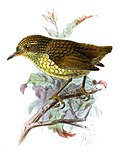Amblyornis
Appearance
| Amblyornis | |
|---|---|

| |
| Streaked bowerbird, Amblyornis subalaris | |
| Scientific classification | |
| Domain: | Eukaryota |
| Kingdom: | Animalia |
| Phylum: | Chordata |
| Class: | Aves |
| Order: | Passeriformes |
| Family: | Ptilonorhynchidae |
| Genus: | Amblyornis Elliot, 1872 |
| Type species | |
| Ptilorhynchus inornatus Schlegel, 1871
| |
Amblyornis is a genus of passerine birds belonging to the bowerbird family Ptilonorhynchidae. The species are endemic to the mountains of New Guinea.
Taxonomy
[edit]The genus Amblyornis was introduced in 1872 by the American zoologist Daniel Giraud Elliot to accommodate a single species, Ptilorhynchus inornatus Schlegel, 1871, the Vogelkop bowerbird, which is the type species by monotypy.[1][2] The genus name combines the Ancient Greek αμβλυοεις/ambluoeis meaning "dull" with ορνις/ornis meaning "bird".[3]
Species
[edit]The genus contains five species:[4]
| Image | Name | Common name | Distribution |
|---|---|---|---|
| Amblyornis flavifrons | Golden-fronted bowerbird | Foja Mountains in the Papua province of Indonesia. | |
| Amblyornis macgregoriae | MacGregor's bowerbird | New Guinea | |
| Amblyornis germanus | Huon bowerbird | Huon peninsula | |
| Amblyornis subalaris | Streaked bowerbird | southeastern New Guinea | |
| Amblyornis inornata | Vogelkop bowerbird | Vogelkop Peninsula at Western New Guinea, Indonesia. |
References
[edit]- ^ Elliot, Daniel Giraud (1872). "Descriptions of two new genera of Paradiseidae, with remarks on some of the species". Ibis. Series 3. 2: 111-114 [113].
- ^ Mayr, Ernst; Greenway, James C. Jr, eds. (1962). Check-List of Birds of the World. Vol. 15. Cambridge, Massachusetts: Museum of Comparative Zoology. p. 176.
- ^ Jobling, James A. "Amblyornis". The Key to Scientific Names. Cornell Lab of Ornithology. Retrieved 22 February 2025.
- ^ Gill, Frank; Donsker, David; Rasmussen, Pamela, eds. (February 2025). "Lyrebirds, scrubbirds, bowerbirds, Australasian treecreepers, Australasian wrens". IOC World Bird List Version 15.1. International Ornithologists' Union. Retrieved 30 May 2025.

